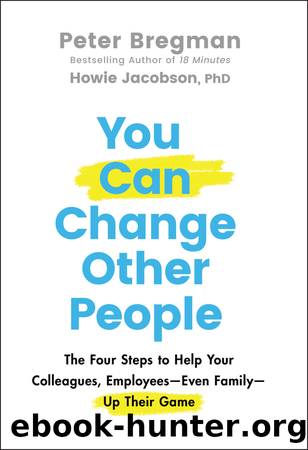You Can Change Other People by Bregman Peter;Jacobson Howie; & Howie Jacobson

Author:Bregman, Peter;Jacobson, Howie; & Howie Jacobson [Bregman, Peter & Jacobson, Howie]
Language: eng
Format: epub
Publisher: John Wiley & Sons, Incorporated
Published: 2021-09-22T00:00:00+00:00
CHAPTER 19
QUESTION 1: WHAT'S HAPPENING NOW?: EXPLORE THE PROBLEM IN DEPTH
Why, you might be wondering, do we wait until Step 3 to explore the problem in depth?
Because before now, the answer would have been haphazard, rambling, and misleading.
Here's why: Before, when your partner was focused on the problem, they would have described what's happening in relation to the problem they thought they had.
Now though? We can guide them to describe what's happening in relation to the outcome they want. That could not happen before clarifying the outcome.
Your goal is to collect data (the facts of the situation), as well as get your partner's perspective on that data. Essentially, you want to see what they see and how they see it. This will give you the basic shape of the situation, help you empathize with their point of view, and begin to explore where and how their interpretation of that situation is getting in the way of the outcome they want.
A reminder I can't share often enough: Keep your empathy level high here (without taking on their emotions as your own).
When people describe their unsatisfactory situations, they can get down on themselves. Sometimes they express this as self-criticism, and sometimes they project it outward, blaming others for the situation. The more you build rapportâunderstanding without judging and being the ally who believes in their capabilities and positive intentionsâthe less defensive they will become. This is important because, as we've seen, defensiveness blocks creativity, and without creativity, they will just keep repeating the same ineffective strategies.
It's crucial that you remain genuinely curious so that you don't just follow this process as a checklist. If you're actually curiousâcurious like a wide-eyed 6-year-old to whom the world is still wonderful and fascinatingâthis process will feel natural to you and your partner. If you're trying to âfakeâ curiosity, your partner will sense that you don't really care.
Don't:
DARA: Tell me what's happening now with your team.
BEN: Ramona isn't the leader, but she keeps bossing everyone around.
DARA: Uh-huh. So what have you tried?
In this dialogue, Dara isn't curious about what's actually happening. Instead, she's accepted the label that Ben slapped on the situation: âRamona is bossing everyone around.â In other words, Ramona herself is the problem. If that's true, then the only solutions are to get rid of Ramona or neutralize her influence in some other way.
Don't accept your partner's labels. Instead, ask them to describe specifically what's going on.
Do:
DARA: Tell me what's happening now with your team.
BEN: Ramona isn't the leader, but she keeps bossing everyone around.
DARA: Tell me more about that. What exactly is she doing and saying?
BEN: She talks over people in meetings and argues with everyone about features and priorities. She's convinced that she has the answer and the rest of us are idiots.
Dara asks for hard facts, rather than labels or interpretations of those facts, in three ways.
First, she asks Ben, âTell me more.â Second, she deliberately uses the word exactly. Third, she asks for behaviors, what Ramona is âdoing and saying.â
In response, Ben shares specific facts: talking over people and focusing on features and priorities.
Download
This site does not store any files on its server. We only index and link to content provided by other sites. Please contact the content providers to delete copyright contents if any and email us, we'll remove relevant links or contents immediately.
Tools of Titans by Timothy Ferriss(6936)
Change Your Questions, Change Your Life by Marilee Adams(6637)
Deep Work by Cal Newport(5452)
Man-made Catastrophes and Risk Information Concealment by Dmitry Chernov & Didier Sornette(4728)
Big Magic: Creative Living Beyond Fear by Elizabeth Gilbert(4718)
The Slight Edge by Jeff Olson(4716)
The Motivation Myth by Jeff Haden(4521)
Digital Minimalism by Cal Newport;(4511)
Stone's Rules by Roger Stone(4412)
Ego Is the Enemy by Ryan Holiday(3982)
The Laws of Human Nature by Robert Greene(3936)
Tuesdays with Morrie by Mitch Albom(3828)
Rising Strong by Brene Brown(3777)
Eat That Frog! by Brian Tracy(3508)
Skin in the Game by Nassim Nicholas Taleb(3456)
The Money Culture by Michael Lewis(3276)
Skin in the Game: Hidden Asymmetries in Daily Life by Nassim Nicholas Taleb(3259)
Believe It to Achieve It by Brian Tracy & Christina Stein(3201)
Bullshit Jobs by David Graeber(3173)
